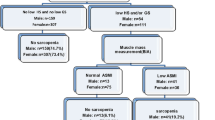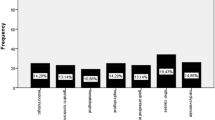Abstract
Background
The aim of this study is to identify the prevalence, assess the metabolic profile, and key differences (versus healthy) in a cohort of subjects with sarcopenia (S) and in sarcopenic obesity (SO) hospitalized elderly.
Methods
A standardized comprehensive geriatric assessment was performed. We enrolled 639 elderly subjects (196 men, 443 women) with a mean age of 80.90 ± 7.77 years. Analysis of variance and a multinomial logistic regression analysis adjusting for covariates were used to assess the differences between groups.
Results
The prevalence of (S) was 12.42% in women and 23.47% in men. (SO) was 8.13% in women and 22.45% in men. Data showed that either groups had a functional impairment (Barthel index < 50 points). (S) had the mean value of erythrocyte sedimentation rate (ESR) (>15 mm/h), CPR (>0.50 mg/dl) homocysteine (>12 micromol/l), and hemoglobin (<12 g/dl). Ferritin level over the range (>145 mcg/dl) was detected in either cohort (due to inflammation). (SO) had glycemia (>110 mg/dl). Key differences in (S) cohort (versus healthy) were a reduction in functional impairment (p < 0.001), an increase in white blood cell (p < 0.01), a decrease in iron level (p < 0.05), in electrolytes balance (Na: p < 0.01 and Cl: p < 0.01), and tyroid function (TSH: p < 0.001). In addition, (S) had higher state of inflammation (erythrocyte sedimentation rate: p < 0.05 and C-reactive protein: p < 0.01), and an increase of risk of fractures (FRAX: OR 1.07; p < 0.001), risk of malnutrition (mini nutritional assessment: p < 0.001), and risk of edema (extra cellular water: p < 0.001). In (SO) cohort, an increase in white blood cell (p < 0.001) and erythrocyte sedimentation rate (p < 0.05) was observed.
Conclusions
(S) subjects appears more vulnerable than (SO). Sarcopenia is closely linked to an increase in the risk of hip–femur fractures, inflammation, edema, and malnutrition. The (SO) subjects seem to benefit from the “obesity paradox.”


Similar content being viewed by others
Change history
31 March 2017
An erratum to this article has been published.
References
Cruz-Jentoft AJ, Baeyens JP, Bauer JM et al (2010) Sarcopenia: European consensus on definition and diagnosis: report of the European Working Group on Sarcopenia in Older People. Age Ageing 39:412–423
Baumgartner RN, Koehler KM, Gallagher D et al (1998) Epidemiology of sarcopenia among the elderly in New Mexico. Am J Epidemiol 147:755–763
Kim JH, Cho JJ, Park YS (2015) Relationship between sarcopenic obesity and cardiovascular disease risk as estimated by the Framingham risk score. J Korean Med Sci 30:264–271
Zamboni M, Mazzali G, Fantin F, Rossi A, Di Francesco V (2008) Sarcopenic obesity: a new category of obesity in the elderly. Nutr Metab Cardiovasc Dis 18:388–395
Lim S, Kim JH, Yoon JW et al (2008) Sarcopenic obesity: prevalence and association with metabolic syndrome in the Korean longitudinal study on Health and aging (KLoSHA). Diabetes Care 33:1652–1654
Schrager MA, Metter EJ, Simonsick E, Ble A, Bandinelli S, Lauretani F et al (2007) Sarcopenic obesity and inflammation in the InCHIANTI study. J Appl Physiol 102:919–925
Batsis JA, Mackenzie TA, Jones JD, Lopez-Jimenez F, Bartels SJ (2016) Sarcopenia, sarcopenic obesity and inflammation: results from the 1999–2004 National Health and Nutrition Examination Survey. Clin Nutr. doi:10.1016/j.clnu.2016.03.028
Yang CW, Li CI, Li TC et al (2015) Association of sarcopenic obesity with higher serum high-sensitivity C-reactive protein levels in Chinese older males-A community-based study (Taichung Community Health Study-Elderly, TCHS-E). PLoS ONE 10:e0132908
Kim TN, Won JC, Kim YJ, et al (2013) Serum adipocyte fatty acid-binding protein levels are independently associated with sarcopenic obesity. Diabetes Res Clin Pract 101:210–217
Scott D, Seibel M, Cumming R, et al (2016) Sarcopenic obesity and its temporal associations with changes in bone mineral density, incident falls, and fractures in older men: the concord health and ageing in men project. J Bone Min Res. doi:10.1016/j.juro.2016.06.085
Miyai N, Uematsu Y, Iwahara A (2016) Mps 10–04 the combination of obesity and sarcopenia is associated with cognitive decline in elderly hypertensive individuals. J Hypertens 34:e267
Levine ME, Crimmins EM (2012) Sarcopenic obesity and cognitive functioning: the mediating roles of insulin resistance and inflammation? Curr Gerontol Geriatr Res. doi:10.1155/2012/826398
Hamer M, Batty GD, Kivimaki M (2015) Sarcopenic obesity and risk of new onset depressive symptoms in older adults: English longitudinal study of ageing. Int J Obes. doi:10.1038/ijo.2015.124
Prado CM, Lieffers JR, McCargar LJ et al (2008) Prevalence and clinical implications of sarcopenic obesity in patients with solid tumours of the respiratory and gastrointestinal tracts: a population-based study. Lancet Oncol 9:629–635
Plauth M, Cabré E, Riggio O et al (2006) ESPEN guidelines on enteral nutrition: liver disease. Clin Nutr 25:285–294
Vasan RS, Levy D (2000) Defining diastolic heart failure a call for standardized diagnostic criteria. Circulation 101:2118–2121
Hoste EA, Clermont G, Kersten A et al (2006) RIFLE criteria for acute kidney injury are associated with hospital mortality in critically ill patients: a cohort analysis. Crit care 10:1
Folstein MF, Folstein SE, McHugh PR (1975) “Mini-mental state”: a practical method for grading the cognitive state of patients for the clinician. J Psychiatr Res 12:189–198
Joosen AM, Bakker AH, Westerterp KR (2005) Metabolic efficiency and energy expenditure during short-term overfeeding. Physiol Behav 85:593–597
Baumgartner RN, Wayne SJ, Waters DL, Janssen I, Gallagher D, Morley JE (2004) Sarcopenic obesity predicts instrumental activities of daily living disability in the elderly. Obes Res 12:1995–2004
Klein BE, Klein R, Knudtson MD, Lee KE (2005) Frailty, morbidity and survival. Arch Gerontol Geriatr 41:141–149
Kanis JA, Oden A, Johansson H, Borgström F, Ström O, McCloskey E (2009) FRAX® and its applications to clinical practice. Bone 44:734–743
Rolfson DB, Majumdar SR, Tsuyuki RT, Tahir A, Rockwood K (2006) Validity and reliability of the Edmonton Frail Scale. Age Ageing 35:526–529
Mathiowetz V, Rennells C, Donahoe L (1985) Effect of elbow position on grip and key pinch strength. J Hand Surg Am 10:694–697
Landi F, Liperoti R, Russo A et al (2012) Sarcopenia as a risk factor for falls in elderly individuals: results from the il SIRENTE study. Clin Nutr 31:652–658
Mahoney FI, Barthel DW (1965) Functional evaluation: the barthel index, Maryland State. Med J 14:61–65
Yesavage JA, Rose TL, Lum O et al (1983) Development and validation of geriatric depression screening: a preliminary report. J Psychiatr Res 17:37–49
Katz S, Ford AB, Moskowitz RW, Jackson BA, Jaffe MW (1963) Studies of illness in the aged: the index of ADL: a standardized measure of biological and psychosocial function. JAMA 185:914–919
Guigoz Y, Vellas BJ (1997) Malnutrition in the elderly: the mini nutritional assessment (MNA). Ther Umsch 54:345–350
Lewitt A, Mądro E, Krupienicz A (2007) Podstawy teoretyczne i zastosowania analizy impedancji bioelektrycznej (BIA). Endokrynologia Otyłość Zaburzenia Przemiany Materii 3:79–84.
Kemmler W, Von Stengel S, Engelke K, Sieber C, Freiberger E (2016) Prevalence of sarcopenic obesity in Germany using established definitions. Osteoporosis Int 27:275–281.
Stephen WC, Janssen I (2009) Sarcopenic-obesity and cardiovascular disease risk in the elderly. J Nutr Health Aging 13:460–466
Nishiguchi, S, Yamada M, Shirooka H, et al (2016) Sarcopenia as a risk factor for cognitive deterioration in community-dwelling older adults: a 1-year prospective study. JAMDA 17:372–375.
Kim NH, Kim HS, Eun CR et al (2011) Depression is associated with sarcopenia, not central obesity, in elderly Korean men. J Am Ger Soc 59:2062–2068
Morandi A, Onder G, Fodri L, et al (2016) The association between the probability of sarcopenia and functional outcomes in older patients undergoing in-hospital rehabilitation. JAMDA 16:951–956.
Joppa P, Tkacova R, Franssen FM, et al (2016) Sarcopenic Obesity, Functional Outcomes, and Systemic Inflammation in Patients With Chronic Obstructive Pulmonary Disease. JAMDA
Cesari M, Kritchevsky SB, Baumgartner RN et al (2005) Sarcopenia, obesity, and inflammation—results from the trial of angiotensin converting enzyme inhibition and novel cardiovascular risk factors study. Am J Clin Nutr 82:428–434
Wilson JG, Lindquist JH, Grambow SC, Crook ED, Maher JF (2003) Potential role of increased iron stores in diabetes. Am J Med Sci 325:332–339
Chung JY, Kang HT, Lee DC, Lee HR, Lee YJ (2013) Body composition and its association with cardiometabolic risk factors in the elderly: a focus on sarcopenic obesity. Arch Gerontol Geriatr 56:270–278
Leng S, Chaves P, Koenig K, Walston J (2002) Serum interleukin-6 and hemoglobin as physiological correlates in the geriatric syndrome of frailty: a pilot study. J Am Ger Soc 50:1268–1271
Lasocki S, Chudeau N, Papet T et al (2014) Prevalence of iron deficiency on ICU discharge and its relation with fatigue: a multicenter prospective study. Crit Care 18:542
Visser M, Kritchevsky SB, Newman AB et al (2005) Low serum albumin concentration and change in muscle mass: the health, aging, and body composition study. Am J Clin Nutr 82:531–537
Oliveira A, Vaz C (2015) The role of sarcopenia in the risk of osteoporotic hip fracture. Clin Rheumatol 34:1673–1680
Dumescic DA, Abbott DH, Eisner JR, Herrmann RR, Reed JE, Welch TJ (1998) Pituitary desensitisation to gonadotropin-releasing hormone increases abdominal adiposity in hyperandrogenic anovulatory women. Fertil Steril 70:94–101
Thrailkill KM, Lumpkin CK Jr, Bunn RC, Kemp SF, Fowlkes JL (2005) Is insulin an anabolic agent in bone? Dissecting the diabetic bone for clues. Am J Physiol Endocrinol Metab 289:735–745
Cornish J, Reid IR (2001) Effects of amylin and adrenomedullin on the skeleton. J Musculoskelet Neuronal Interact 2:15–24.
Agabaht K, Guurlek A, Karakaya J, Bayraktar M (2009) Circulating adiponectin represents a biomarker of the association between adiposity and bone mineral density. Endocr 35:371–379
Rondanelli M, Guido D, Opizzi A, Faliva MA, Perna S, Grassi M (2014) A path model of sarcopenia on bone mass loss in elderly subjects. J Nutr Health Aging 18:15–21
Kyle UG, Genton L, Pichard C (2013) Low phase angle determined by bioelectrical impedance analysis is associated with malnutrition and nutritional risk at hospital admission. Clin Nutr 32:294–299
Yamada Y, Schoeller DA, Nakamura E, Morimoto T, Kimura M, Oda S (2010) Extracellular water may mask actual muscle atrophy during aging. J Gerontol A Biol Sci Med Sci 65:510–516
Author information
Authors and Affiliations
Corresponding author
Ethics declarations
Conflict of interest
The authors declare that there is no conflict of interest regarding the publication of this paper.
Research involving human and animal rights
The investigation was undertaken within the framework of a protocol approved by the Medical School Ethics Committee.
Informed consent
Participants in the cohorts included in this analysis provided informed consent at enrollment.
Additional information
The original version of this article was revised: The name of the third author has been incorrectly published as Faliva Milena Anna. The correct name is Milena Anna Faliva.
An erratum to this article is available at https://doi.org/10.1007/s40520-017-0751-6.
Rights and permissions
About this article
Cite this article
Perna, S., Peroni, G., Faliva, M.A. et al. Sarcopenia and sarcopenic obesity in comparison: prevalence, metabolic profile, and key differences. A cross-sectional study in Italian hospitalized elderly. Aging Clin Exp Res 29, 1249–1258 (2017). https://doi.org/10.1007/s40520-016-0701-8
Received:
Accepted:
Published:
Issue Date:
DOI: https://doi.org/10.1007/s40520-016-0701-8




